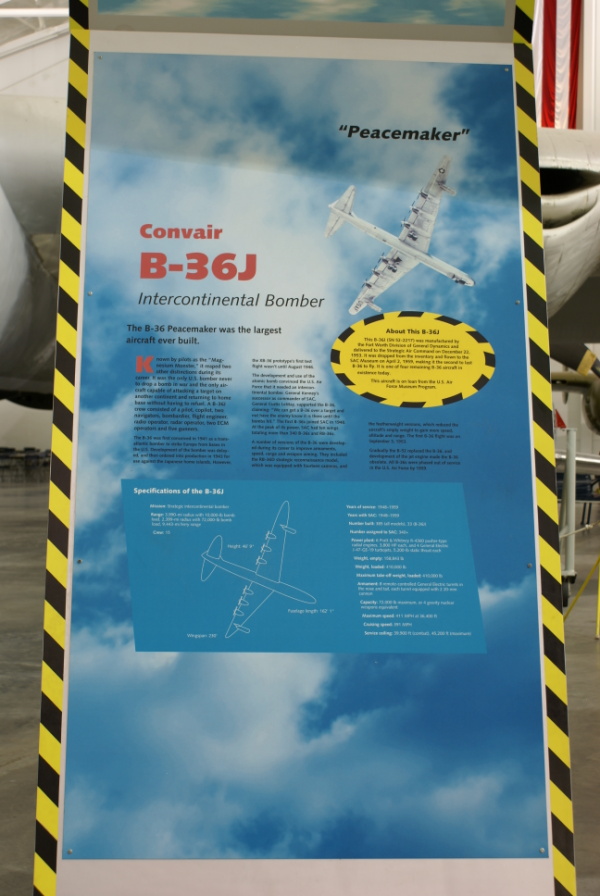| Prev |
heroicrelics.org Strategic Air Command & Aerospace Museum Site Index B-36 Peacemaker Gallery |
Next |
dsc44603.jpg
The sign accompanying the aircraft. It reads
"Peacemaker"
Convair
B-36J
Intercontinental BomberThe B-36 Peacemaker was the largest aircraft ever built.
Known by pilots as the "Magnesium Monster," it reaped two other distinctions during its career. It was the only U.S. bomber never to drop a bomb in war and the only aircraft capable of attacking a target on another continent and returning to home base without having to refuel. A B-36J crew consisted of a pilot, copilot, two navigators, bombardier, flight engineer, radio operator, radar operator, two ECM operators and five gunners.
The B-36 was first conceived in 1941 as a trans-Atlantic bomber to strike Europe from bases in the U.S. Development of the bomber was delayed, and then ordered into production in 1943 for use against the Japanese home islands. however, the XB-36 prototype's first flight wasn't until August 1946.
The development and use of the atomic bomb convinced the U.S. Air Force that i needed an intercontinental bomber. General Kenney's successor as commander of SAC, General Curtis LeMay, supported the B-36, claiming: "We can get a B-36 over a target and not have the enemy know it is there until the bombs hit." The first B-36s joined SAC in 1948. At the peak of its power, SAC had ten wings totaling more than 340 B-36s and RB-36s.
A number of versions of the B-36 were developed during its career to improve armaments, speed, range, and weapon aiming. They included the RB-36D strategic reconnaissance model, which was equipped with fourteen cameras, and the featherweight versions, which reduced the aircraft's empty weight to gain more speed, altitude, and range. The first B-36 flight was on September 3, 1953.
Gradually the B-52 replaced the B-36, and development of the jet engine made the B-36 obsolete. All B-36s were phased out of service by in the U.S. Air Force by 1959.
About This B-36J
This B-36J (SN 52-2217) was manufactured by the Forth Worth Division of General Dynamics and delivered to the Strategic Air Command on December 22, 1953. It was dropped from the inventory and flown to the SAC Museum on April 2, 1959, making it the second to last B-36 to fly. It is one of four remaining B-36 aircraft in existence today.
This aircraft is on loan from the U.S. Air Force Museum Program.
Specifications of the B-36J
Mission: Strategic intercontinental bomber
Range: 3,990-mi radius with 10,000-lb bomb load, 2,399-mi radius with 72,000-lb bomb load, 9,443-mi ferry range
Crew: 15
Height: 46' 9"
Fuselage length: 162' 1"
Wingspan: 230'
Years of service: 1948-1959
Years with SAC: 1948-1959
Number built: 385 (all models), 33 (B-36J)
Number assigned to SAC: 340+
Power Plant: 6 Pratt & Whitney R-4360 pusher-type radial engines, 3,800 HP each, and 4 General Electric J-47-GE-19 turbojets, 5,200-lb static thrust each
Weight, empty: 158,843 lb
Weight, loaded: 410,000 lb
Maximum take-off weight, loaded: 410,000 lb
Armament: 8 remote-controlled General Electric turrets in the nose and tail, each turret equipped with 2 20-mm cannon
Capacity: 72,000 lb maximum, or 4 gravity nuclear weapons equivalent
Maximum speed: 411 MPH at 36,400 ft
Cruising speed: 391 MPH
Service ceiling: 39,900 ft (combat) 42,200 ft (maximum)

| Time picture taken | Sun Jul 27 14:07:02 2008 |
| Location picture taken |
Hangar A Strategic Air & Space Museum Ashland, NE |
| Prev |
heroicrelics.org Strategic Air Command & Aerospace Museum Site Index B-36 Peacemaker Gallery |
Next |